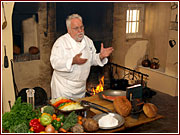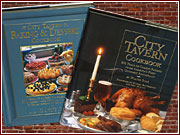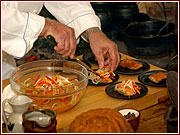IN PRAISE OF OPEN-HEARTH COOKING
Celebrity Chef Walter Staib Sets Up Shop in Camden's Pomona Hall
By Hoag Levins
 | |
 November, 2008
November, 2008
CAMDEN, N.J. -- Celebrity chef Walter Staib's latest trip to Camden turned out to be as much a cooking demonstration as it was a sentimental journey.


Photo: Hoag Levins
|
Celebrity chef Walter Staib hosted a Camden County Historical Society fundraiser in the open-hearth kitchen of Pomona Hall. He's the author of three cookbooks and the star of the "World Cuisine of the Black Forest" show on Comcast's CN8.
|
The TV star, cookbook author and renowned restaurateur was the host of a Camden County Historical Society fundraiser in the 18th-century kitchen of Pomona Hall. Standing before a towering open-hearth and roaring fire in the restored 1788 mansion, Staib demonstrated the preparation and cooking of gourmet food in pots and pans maneuvered over piles of glowing coals. The 62-year-old chef, who speaks with a heavy German accent, operates Philadelphia's City Tavern and is an authority on 18th-century tavern cooking. But he also surprised the audience with a nostalgic story about how he had become such a good wood-fire cook. He was born and grew up in the Black Forest region of Germany in a family of restaurateurs who cooked with real wood fires. He recalled how in that post-World War II era there was neither gas nor electricity in that region of Germany.
Child apprentice
"As a child, I became an apprentice and keeping the fire was the most important part of the job," he said. "The fire had to be going and just right by the time the cooks arrived or you got in a whole bunch of trouble. Without a proper fire, there was no business."


Photo: Hoag Levins
|
Chef Walter Staib is the author of three cookbooks: "City Tavern Cookbook," "City Tavern Baking & Dessert Cookbook," and "Black Forest Cuisine." The new edition of "City Tavern Cookbook" is due to be published in the spring of 2009.
|
He worked in his uncle Walter and aunt Ruth's kitchen and butcher shop until he was fourteen, when he became an apprentice in the Black Forest's famous Hotel Post in nearby Nagold, Germany. And between the two experiences, his evolving sense of himself and his culinary art became forever anchored in old world cooking traditions.
"City Tavern, with all of its modern stoves, is where my pocketbook is," he told the Pomona Hall audience. "But standing here in a real open-hearth kitchen, with a wood fire behind me, is where my heart is."
TV camera crew
"Earlier this year when we brought a TV camera crew here to Pomona Hall to film one of my TV cooking shows," he explained, "the guys thought it all looked so crude. They were amazed that we were actually cooking all these different things. And then, they were more amazed that everything tasted so good."
"A lot of people think this is crude cooking," he said, gesturing broadly to the huge stone hearth behind him. "But it's not. We know from historical documents that what was being cooked and eaten from City Tavern's wood fire kitchens in the 18th century was very high quality stuff. It was like the food you get in fancy French or European-style restaurants today. Back then, Philadelphia was the second largest city in the western world and a very sophisticated place. Philadelphia (gentry) were not ripping meat off the bones with their hands for dinner. They were eating gourmet food prepared over wood fires like this."


Photo: Hoag Levins
|
Chef Walter Staib puts the finishing touches on salmon escoveitch. At his City Tavern restaurant and in his cookbooks, Staib focuses on the foods and recipes of 18th-century Philadelphia.
|
"Of course, you have to have experience and know how to do this sort of cooking. You've got to know how to feed the fire and manipulate the coals and manage the heat," he said. "And you have to be very organized and keep a keen eye on what you're doing. But the results are worth it. You can cook a very elegant five-course meal on this hearth, which is what I'm sure the people who lived in this historic house often did back in the 1700s."
For the afternoon's demonstration, the chef made and discussed the long history of West Indies pepper-pot soup and salmon escoveitch accompanied by Thomas Jefferson sweet potato and pecan biscuits and Anadama bread, a form of bread made in the American colonies from cornmeal, wheat flour and molasses.
In-depth historical research
In fact, everything about the day's featured meal preparation was as much a lesson about local history as it was about cooking. Staib's City Tavern restaurant cuisine and his City Tavern cookbooks are grounded in the deeply-researched history of food, particularly that of the Delaware Valley in the 1700s.
Pepper-pot soup was a food of the people -- made with cheap meats, vegetables, peppers and hot spices. It was a one-pot meal that was quick and convenient to make -- and George Washington is said to have fed his troops pepper-pot soup after crossing the Delaware for his attack on Trenton in 1776. The original version of pepper-pot soup, which Staib prepared, came to Philadelphia from the West Indies in the colonial period. It's made with a richer blend of ingredients, including taro root.
Salmon escoveitch, another dish that came to the Delaware Valley from the West Indies, is an equally spicy recipe. The word "escoveitch" is derived from a Spanish term meaning "pickled" because that's actually what happens when you combine just-cooked fish with chopped vegetables steeped in a marinade of three kinds of peppers and vinegar. Aside from being tasty, the marinade chemically preserved the fish, Staib explained. "In the 18th century, the final platter could be stored in the larder or spring house for later eating. That's why peppers and spices were so heavily used then. They were preservatives as well as good tasting ingredients."
Pomona Hall's kitchen
The chef, who has just completed a completely new edition of his City Tavern Cookbook due out in the spring, said he had only recently learned of the existence of Pomona Hall and its large old-time kitchen.
For several years, he said, he's been trying unsuccessfully to gain access to the open-hearth kitchen of Thomas Jefferson's Monticello estate in Virginia to film his historic cooking TV shows. Then, a little over a year ago, he was on the web researching colonial kitchen gardens in the Delaware Valley when he unexpectedly came across a web page about Pomona Hall's own colonial kitchen garden. Its links included photo pages of the mansion's fully-functional and authentically equipped open-hearth kitchen.
"We couldn't believe there was such a place in Camden, just across the river," he said. "We jumped in the car and came over to see it and when I walked into the room, all I could say was 'Wow!' It really was like stepping back in time."
His publisher -- Running Press of Philadelphia -- subsequently sent a photographer to shoot the kitchen and other rooms of Pomona Hall. Staib said one of those photos from the restored historic mansion will open each chapter of his new book.
All Rights Reserved © 2008, Hoag Levins
HoagL@earthlink.net
About this Web site
| 








